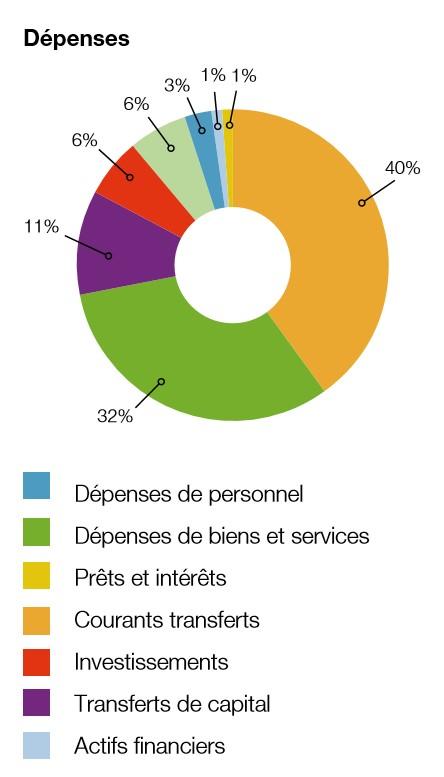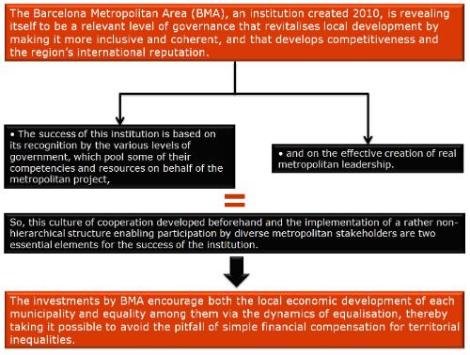Barcelona Metropolitan Area: Working Together to Do Better
2014
Fonds mondial pour le développement des villes (FMDV)
New institution established in 2010, the Barcelona Metropolitan Area aims to foster an effective territorial development in a context of scarce resources.
Faced with the rise in local needs (in urban planning, development and renewal) and under the effect of globalisation, institutionalised metropolisation and inter-municipalisation represent opportunities for economies of scale, resource syndication and socio-economic performance.
Barcelona and its surrounding area are a dynamic and attractive region for investors, generating more than half of Catalonia’s GDP1. The area was deeply affected by the 2008 financial crisis, and it has long been characterised by a very complex administrative situation, with intermittent political tension. However, in 2010, the area created an inter-municipal level, the Barcelona Metropolitan Area (BMA). By positioning local economic development and territorial cohesion at the heart of the metropolitan project, the BMA makes it possible to implement ambitious infrastructures and services.
Para descargar: local_innovations.pdf (1,5 MiB)
Even though the need for a metropolitan institution was acknowledged and sketched out as early as the 1950s2 the various successive metropolitan bodies turned out to be inadequate or poor performers. Adopted in 2010 by the Catalonian parliament, Law 31/2010 laid the foundations for a new institution, the Barcelona Metropolitan Area (BMA). It seeks to optimise territorial management (with a “global” profile since the summer Olympic Games of 1992) and its economic development, and to deal with contexts of systemic crisis and intensified competition among metropolitan areas at a global level. The BMA replaced three metropolitan institutions with distinct prerogatives and different numbers of municipalities. Today it is made up of 36 municipalities and has established a single metropolitan zone over which it has extended its authority.
Efficient institutional interplay: a crucial factor in mobilising resources
While the BMA represents 2% of Catalonia’s land surface, it is home to nearly 43% of its population. The BMA has taken over the historic prerogatives of the previous metropolitan institutions (land-use planning and transportation, waste management, water supply and social housing3),and in addition has increased authority in urban planning, territorial and social cohesion, economic development, and territorial organisation. By bringing together a team of 500 professionals into a single body, it seeks to be a vector of optimisation for resource and investment management, capacity building and good territorial governance, which will help it to implement a socially responsible, shared and inter-connected metropolitan strategy, as well as contribute to its international reputation. The 36 member municipalities play a crucial role in financing the institution and its government. Mayors and councillors elected from each municipality sit on the Metropolitan Council, the body that supervises the public policies that are developed, appoints the president, and adopts the agreements and regulations. Some municipal competency is also shared and/or delegated to the BMA, which lightens their duties all the while increasing territorial coherency and investment performance. The 2008 crisis affected the budget capacities of many Catalonian municipalities, strongly impacting the economic dynamism of the region. In this context, the existence of the BMA makes it possible to mobilise a large volume of resources and to implement attractive projects on a metropolitan scale. The institution has a budget of €606 million for 2014, which comes mainly from transfers from other administrative levels of the metropolitan and regional territory (45%, of which more than half comes from the member municipalities) and public taxes established by the BMA4 (around 40%). This shows its capacity to catalyse financial resources from different institutional and territorial actors for the metropolitan project.

Source : Made based on BMA data

Source : Made based on BMA data
Local economic development and territorial solidarity at the centre of the metropolitan project
Above and beyond competencies in public service management and improvement in the quality of life of its inhabitants, the BMA allocates a significant share of its budget to capacity building and cooperation among the local administrations. This way, it combines investments for local development, equalisation dynamics and efficiency in local public action. As an example, the 2012-2015 Investment Plan establishes an active equalisation policy, with funding lines distributed in direct proportion to the population of each municipality, as well as a specific budget dedicated to the municipalities for which the socio-economic level is lower than the average of the BMA. Further, the “Economic Activity and Quality of Life stimulation plan5” was designed as a specific tool to help in economic recovery, job creation and improvement in quality of life. It is structured into four sub-programmes dedicated to support for municipal housing enterprises, building rehabilitation, neighbourhood and infrastructure improvement, and competitiveness of economic-activity sectors within each municipality6. This 2012-2015 programme, funded by the metropolitan region at €160 million, targets private investments by achieving leverage, making it possible to double the investments made by BMA and to have strong positive repercussions on the area. Combined with active participation in international networks and European programmes, these coordinated strategies work to revitalise the metropolitan area as a whole, establish the institutional position of the BMA, and confer it its “global metropolis” dimension.
Promising prospects for the future
The BMA is an economic and political project as much as an institutional one. It has quickly been able to show its capacity to organise itself, to gather resources and to ensure their programmatic equalisation, while at the same time distinguishing itself as a federator in both land-use planning and in the provision of public services, as well as a credible negotiator of other territorial levels (Generalitat and Diputacio). Having simplified the metropolitan administrative map and incorporated a range of competencies within a single institution, the BMA is emerging as an effective and coherent territorial leader that has generated – for the first time – real political awareness of the essence of “metropolis” and of its importance for tapping into opportunities created by its international reputation. As the institution is very recent, it for now has few documents that can demonstrate results of plans implemented since 2011, and the effectiveness and success of projects inscribed in the short and long terms, which guarantee the credibility of the structure, have yet to be proven. However, the BMA is now consulted regularly by other budding European metropolises to share in its institutional experience. It is also producing statistical data promoting the excellence of its local dynamics and showing the prospects for an urban area with strong potential and added value. Presently, as with any metropolitan process of inter-municipalisation, the future challenges concern continued political support from the local institutional actors (Generalitat, municipalities, Diputacio) and coherent balance between local-economy development dynamics and international competitiveness. The choice of criteria for businesses setting up there and of support for revitalisation projects brings up the question of balance between the different levels of action. The BMA marks a breaking off with the complex administrative history of the metropolitan region, and this Catalonian experience is in the process of becoming a European reference in socially responsible metropolitan organisation and integration.

from FMDV, 2014
1 In 2011, 51% of jobs in Catalonia as well as most of its dynamic economic sectors were concentrated in the Barcelona metropolitan region.
2 The first Barcelona Urban Planning Commission, made up of 27 municipalities, was created in 1953. The first Barcelona Metropolitan Corporation (BMC) was created in 1974 but dissolved in 1987 due to political disagreements.
3 The Entitat Metropolitana de Serveis Hidràulics i Tractament de Residus (EMSHTR), a water and waste management service made up of 33 municipalities; the Entitat metropolitana del Transport (EMT), in charge of transportation in 18 municipalities; and the Mancomunitat de municipis (MMAMB), the guarantor of the implementation of the metropolitan development plan worked out in 1976 in 31 municipalities.
4 Taxes for water and waste management and supplement to property tax, among others 4. Pla d’estimul de l’activitat economica i la qualitat de vida
5 Pla d’estimul de l’activitat economica i la qualitat de vida
6 As an example, this programme devotes funding lines to the renovation of infrastructures in industrial zones in order to facilitate businesses setting up there.
Para ir más allá
I General information (in Catalonian)
Article on the issues behind the creation of the BMA: Roig i Marti J . and Haro Garcia J .L (2011), La ley del Area Metropolitana de Barcelona, una oportunidad para el territorio, in Hacienda Publica Article on the issues of equalisation among local authorities (in French)